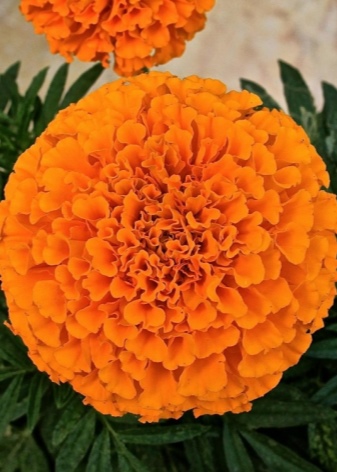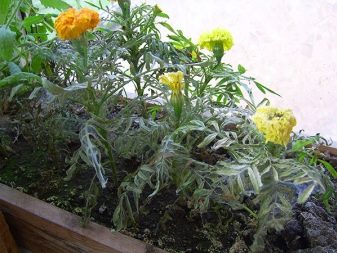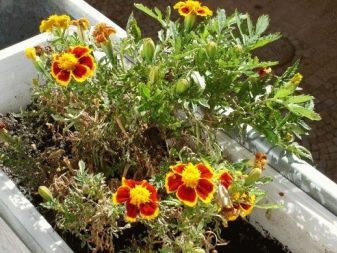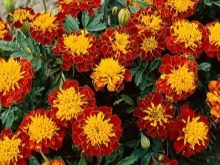Low-growing marigolds: varieties and growing rules

Low-growing marigolds will be an excellent decoration for any garden or suburban area. That is why they are often used in landscape design.
What are the botanical features of this plant species? How to plant and care for flowers? What diseases are marigolds susceptible to? Look for answers to these and some other questions in our material.

Description
First of all, it is important to say that the United States of America is the homeland of the marigolds. In this country, these flowers are common everywhere. Thanks to trade and colonization processes, undersized (or, as they are also called, curb) marigolds have spread throughout the world, including in our country.
An entertaining fact. Marigolds have a huge number of names. So, the famous scientist Karl Linnaeus gave the flowers an unusual name - tagetes in honor of the grandson of the god Jupiter. In England, marigolds are called "Mary's gold", and in Germany - "Turkish carnation". There is also a Ukrainian name for the plant - chernobryvtsy.
If we talk about the biological characteristics of plants, then we cannot but say that these flowers belong to the Asteraceae (or Compositae) family.
A distinctive characteristic of marigolds is an unusual aroma, thanks to which the flower can be distinguished from any other plant. Low-growing varieties of marigolds can reach a length of up to 30 centimeters.
The stems of the flower are erect, and the leaves are dissected, painted in green shades of a dark color palette.


Popular varieties
The low and dwarf varieties of marigolds are among the most popular and are considered the best for flower beds. Also, such plants are planted on lawns and curbs and used as a living decoration of balconies and loggias. Let's consider the most popular varieties and get acquainted with their names.
- "Mandarin". This variety got its name due to its bright orange color, similar to the color of the popular citrus fruit. The length of the bush of marigold varieties "Mandarin" reaches 30 centimeters, and by its nature it is a hybrid. "Mandarin" blooms in the warm season.


- "Tiger's Eye". A distinctive feature of the plant is double spherical flowers, the diameter of which does not exceed 7 centimeters.


- "Petite". Flowers "Petita" have a very unusual color - the color can vary from dark orange to almost red.

- "Gabi". "Gabi" has bright yellow, almost lemon flowers.

- "Bolero". This variety of low-growing marigolds is one of the most popular due to its unpretentious care. Most often, it is with him that young novice gardeners begin to breed black shavers.

- Brocada Yellow. Variety "Brocada Yellow" forms dense and compact bushes. The flowers have a yellow tint (hence the name of the species) and a velvety structure.


- Enterprise F1. Most often, this particular variety is used for growing in containers.

- Vinilla. These marigolds are one of the most unusual ones, their peculiarity is white or cream flowers.


Thus, there is a huge variety of marigold varieties, so it will not be difficult for every homeowner to choose the one that suits individual needs and in accordance with personal preferences. Combinations of colors of different shades will look especially beautiful.For example, on a garden plot, you can create an unusual color palette: from white marigolds to flowers painted in rich orange shades.
Planting and leaving
First of all, it is important to note that marigolds are plants that do not need special specific care. They are quite unpretentious and picky. Thanks to these characteristics, they are chosen by many gardeners. In addition, the plants have an unusual and rather attractive appearance. Experienced gardeners also note the fact that flower seeds retain their germination for 4 years.
Before starting the direct sowing procedure, it is necessary to select a suitable container for this. Particular attention should be paid to the size and volume of the pot. For sowing, you can use an ordinary box designed for seedlings.
At the bottom of the selected sowing container, you need to make holes that are not too large (this can be done with an awl, knife or any other means at hand). Next, we lay out a drainage layer on the bottom, which will ensure the release of excess moisture, as well as free air circulation. As a drainage mixture for marigolds, coarse sand, expanded clay and charcoal are usually used. A bonus of using such a composition will be the fact that the mixture described above, among other things, prevents the occurrence of various fungal diseases.

You can plant marigolds in almost any soil - in this respect, plants are completely unassuming. You can use the land that is sold in flower shops, or you can make your own potting soil. If you choose the second option, then use ingredients such as peat, humus, soil from the garden and sand. Also, a little fungicide is often added to the composition.
Before planting the seeds, they must be kept in a solution of potassium permanganate for about 15 minutes. This manipulation will allow you to grow healthy seedlings. Also, the seeds need to be soaked by wrapping them in a damp cloth. The duration of such a procedure should be 2 days.
After all the manipulations, you can start disembarking. In a prepared container, the seeds are placed at a short distance from each other (at least 2 centimeters). After sowing is finished, do not forget to sprinkle the seeds with potting soil and water as well. You need to keep the container in the dark at an air temperature not lower than 22 degrees Celsius.
After you notice that young sprouts have appeared, you need to rearrange the container in a bright place and change the temperature (lower it to 18 degrees Celsius). In the process of transplanting a plant, do not forget to fertilize. The best option in this regard will be compositions with a high content of nitrogen and potassium.


After the plant is transplanted, it is necessary to carry out all the necessary care measures.
- Watering is recommended 2 times a day. Be careful not to overdo it with the amount of water - otherwise, decay processes will begin and the plant will die.
- After transplanting marigolds into open ground, do not forget to carry out regular and systematic weeding. It is imperative to remove weeds, because they absorb useful and mineral components of the soil, which are necessary for the normal growth and development of your young plants.
- Loosening should not be neglected. This procedure will provide air oxygen access to the plant roots.
- Top dressing must be applied during the growing season.


Disease and pest control
Of course, the best prevention of the appearance of signs of disease or infestation by insect pests is the proper care of the plant. However, sometimes negative factors still appear.
First of all, it is worth remembering that special attention should be paid to the soil if you are growing seeds for seedlings in a container. Do not neglect the required soil composition and do not change it.Otherwise, marigolds can become infected with the so-called black leg - a fungus that cannot be treated.
If you find the presence of pests (often these are slugs and snails), then first of all they must be collected and thrown away, and then a small amount of ash must be poured around each flower, which will become a kind of barrier for such pests.
To avoid infestation of marigolds with mites, you need to humidify the air around the plantings (for example, by spraying).


Reproduction
Reproduction of marigolds can be carried out in two ways: growing seedlings from seeds or direct sowing in open ground. The sowing procedure itself is described above.
It is believed that the breeding procedure is best done in the spring, in particular at the end of March. If you do this, then you will enjoy bright flowering plants in your garden at the very beginning of summer - in June. However, it is important to remember that marigolds do not tolerate subzero temperatures, so if you live in a climatic zone where frosts still persist at the end of March, then the sowing procedure should be postponed.
If you decide to sow flower seeds directly into open ground, then you should wait until June (or at least May). The first young shoots should appear 7 days after sowing.
Beautiful examples
Marigolds are the favorite plants of novice gardeners. A mixture of several varieties of plants will create a colorful greenhouse on your site that will delight the eyes of your household, neighbors, and even just passers-by. Well, their unique aroma will attract beautiful butterflies to your garden.






You can learn more about planting marigolds for seedlings from the following video.







































































































The comment was sent successfully.